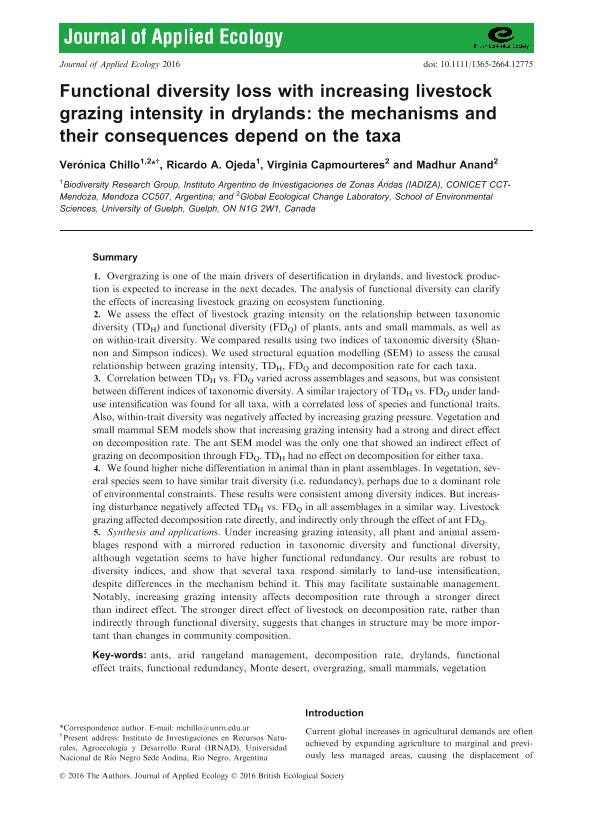Artículo
Functional diversity loss with increasing livestock grazing intensity in drylands: the mechanisms and their consequences depend on the taxa
Fecha de publicación:
17/06/2017
Editorial:
Wiley Blackwell Publishing, Inc
Revista:
Journal of Applied Ecology
ISSN:
0021-8901
Idioma:
Inglés
Tipo de recurso:
Artículo publicado
Clasificación temática:
Resumen
Overgrazing is one of the main drivers of desertification in drylands, and livestock production is expected to increase in the next decades. The analysis of functional diversity can clarify the effects of increasing livestock grazing on ecosystem functioning. We assess the effect of livestock grazing intensity on the relationship between taxonomic diversity (TDH) and functional diversity (FDQ) of plants, ants and small mammals, as well as on within-trait diversity. We compared results using two indices of taxonomic diversity (Shannon and Simpson indices). We used structural equation modelling (SEM) to assess the causal relationship between grazing intensity, TDH, FDQ and decomposition rate for each taxa. Correlation between TDH vs. FDQ varied across assemblages and seasons, but was consistent between different indices of taxonomic diversity. A similar trajectory of TDH vs. FDQ under land-use intensification was found for all taxa, with a correlated loss of species and functional traits. Also, within-trait diversity was negatively affected by increasing grazing pressure. Vegetation and small mammal SEM models show that increasing grazing intensity had a strong and direct effect on decomposition rate. The ant SEM model was the only one that showed an indirect effect of grazing on decomposition through FDQ. TDH had no effect on decomposition for either taxa. We found higher niche differentiation in animal than in plant assemblages. In vegetation, several species seem to have similar trait diversity (i.e. redundancy), perhaps due to a dominant role of environmental constraints. These results were consistent among diversity indices. But increasing disturbance negatively affected TDH vs. FDQ in all assemblages in a similar way. Livestock grazing affected decomposition rate directly, and indirectly only through the effect of ant FDQ. Synthesis and applications. Under increasing grazing intensity, all plant and animal assemblages respond with a mirrored reduction in taxonomic diversity and functional diversity, although vegetation seems to have higher functional redundancy. Our results are robust to diversity indices, and show that several taxa respond similarly to land-use intensification, despite differences in the mechanism behind it. This may facilitate sustainable management. Notably, increasing grazing intensity affects decomposition rate through a stronger direct than indirect effect. The stronger direct effect of livestock on decomposition rate, rather than indirectly through functional diversity, suggests that changes in structure may be more important than changes in community composition.
Archivos asociados
Licencia
Identificadores
Colecciones
Articulos(CCT - PATAGONIA NORTE)
Articulos de CTRO.CIENTIFICO TECNOL.CONICET - PATAGONIA NORTE
Articulos de CTRO.CIENTIFICO TECNOL.CONICET - PATAGONIA NORTE
Articulos(IADIZA)
Articulos de INST. ARG DE INVEST. DE LAS ZONAS ARIDAS
Articulos de INST. ARG DE INVEST. DE LAS ZONAS ARIDAS
Citación
Chillo, María Verónica; Ojeda, Ricardo Alberto; Capmourteres, Virginia; Anand, Madhur; Functional diversity loss with increasing livestock grazing intensity in drylands: the mechanisms and their consequences depend on the taxa; Wiley Blackwell Publishing, Inc; Journal of Applied Ecology; 54; 3; 17-6-2017; 986-996
Compartir
Altmétricas




